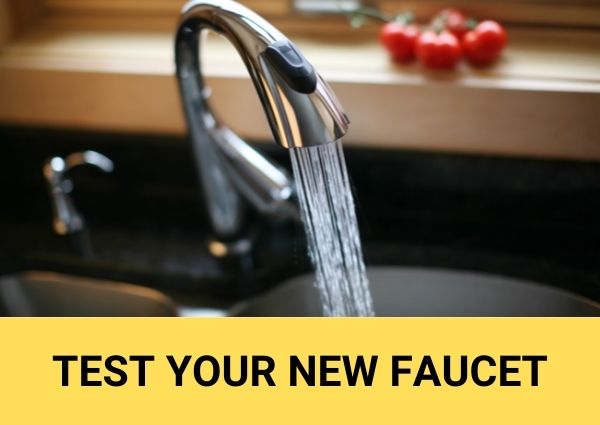Can I replace a kitchen faucet myself? Changing out an old kitchen faucet for a new one is a quick and easy way to update the look of your kitchen. It’s an easy DIY project that you can complete in just a few hours with the right tools and instructions. Before you start, you should prepare everything you need. Then follow these simple steps, and you’ll have your new faucet installed in no time!

How To Choose The Right New Kitchen Faucet?

Here are a few things you need to consider when choosing the right kitchen faucet for your home:
When selecting a finish for your new kitchen faucet, consider what colors and tones will complement the overall look of your kitchen.
You may want to go for a classic Stainless Steel look or something that pops like Copper or Black Stainless Steel.
Whichever route you choose, ensure it fits the rest of your kitchen’s design scheme!
The second is the style. There are many different kitchen faucets available, so it’s essential to choose one that you like the look of and that will fit your kitchen’s overall style.
The third thing to consider is the function. There are many different kitchen faucets, each with its own unique set of features.
You’ll want to choose a faucet with the features you need to make your life easier.
Once you’ve chosen the perfect kitchen faucet, it’s time to install it.
Installing a new kitchen faucet is an easy DIY project that you can do it.
Ensure you have all the necessary tools and materials before installing a new kitchen faucet.
Once you have everything you need, follow these simple steps to install your new kitchen faucet in the kitchen.
How To Install A New Kitchen Faucet?
1. Turn Off The Water To Your Kitchen Sink.

This is usually done by shutting off the valves under the sink. Consult your local plumbing code for guidance if you’re unsure which valves to turn.
To turn off the water supply valves in your home, reach underneath a cabinet and shut them clockwise.
If you don’t have stop valves already installed on each line that leads out from this point (to ensure no leaks), remove all pressure by opening up faucet handles until there is none left whatsoever – be careful not to break anything!
2. Disconnect The Supply Lines From The Old Faucet.

Use an adjustable wrench to loosen the nuts that secure the supply lines to the faucet.
First, disconnect all of its plumbing connections by unscrewing them with an adjustable wrench and ensuring not too much pressure is on any given line, or else there could be leaks from hereon!
After getting those off-kilter, twist back down until they’re hand-tight before tightening each fitting again, using your finger as leverage against turning tools like wrenches which may slip due to lack of grip traction when wet.
3. Remove The Old Faucet.

Depending on your faucet type, you may need to use a basin wrench or other unique tool to remove it.
Removing an old faucet can be tricky, especially if you’re unfamiliar with plumbing.
However, it’s doable with a bit of patience and the right tools.
First, you use a wrench to loosen the faucet’s nuts in place. Once those are loose, you should be able to pull the faucet out of the sink.
If you’re having trouble, you may need to use a utility knife to cut through any caulking that’s holding the faucet in place.
Finally, once the faucet is out, you can start the process of installing the new one.
4. Install The New Faucet.

Follow the instructions that came with your new faucet to install it. Make sure you tighten all the connections securely.
Once the old faucet is removed, clean the sink’s surface to ensure it is free of debris. Then, using the plumber’s putty, create a seal around the base of the new faucet.
Finally, screw on the new faucet and turn on the waterline. Test the faucet to make sure that it is working correctly. If there are any leaks, tighten the screws until they stop.
5. Attach The Supply Lines To The New Faucet.

Use an adjustable wrench to tighten the nuts that secure the supply lines to the faucet.
Installing a new faucet is a fairly straightforward task that most homeowners can complete in the afternoon.
It is essential to use the correct line size to ensure that the inner diameter of the line is slightly larger than the outer diameter of the fitting on the faucet. Once the lines are attached, turn on the water supply lines and check for leaks.
Next, install the new faucet according to the manufacturer’s instructions. Ensure that the faucet is installed securely and that there are no gaps between it and the sink.
Finally, turn on the water and check for leaks again. If there are no leaks, your new faucet is ready to use!
6. Turn On The Water To Your Kitchen Sink And Test Your New Faucet.

Installing a new kitchen faucet is a quick and easy project that You can complete in just a few hours. With the right tools and instructions, you can have your new faucet installed in no time!
New Kitchen Faucet Installation Tips.
Before buying a faucet, you will need to know how many holes your countertop or sink has. Most sinks have one, two, or three holes. If your sink has four holes, you will use one for the sprayer or soap dispenser.
Centerset faucets are a single unit where the handles and spout come together in one spot. This means there’s no need for two different parts, making them easier to clean than other setups!
One option has separate hot and cold water ports on your countertop, so you don’t accidentally use both at once
But suppose this isn’t possible or desirable. In that case, an escutcheon plate (deck plate) can cover up those pesky outer holes while letting you access everything quickly with only one hole required (which makes installation much faster).
When changing a kitchen faucet, there are many different features to consider that can help make your life easier.
One such feature is a pull-down kitchen faucet, which can be extremely helpful when cleaning both the sink and dishes.
Pull-down kitchen faucets typically have a spray head that can be detached from the main faucet, making it easy to direct the water exactly where you need it.
In addition, many pull-down kitchen faucets come with an adjustable flow rate, so you can control how much water comes out at a time. As a result, a pull-down kitchen faucet can be a great way to upgrade your kitchen and make your life easier.
Read more Tips for Installing a Kitchen Faucet
How To Clean New A Kitchen Faucet?
-
- Fill a bowl with warm, soapy water and use it to clean the outside of the faucet.
- Use a soft cloth or sponge to wipe away dirt or grime.
- Rinse the faucet with clean water and dry it with a soft cloth.
- Use a mild cleaning solution and a soft cloth to clean the inside of the faucet.
- Rinse the faucet with clean water and dry it with a soft cloth.
- Use a toothbrush or other small brush to clean hard-to-reach areas.
- Rinse the faucet with clean water and dry it with a soft cloth.
- Use a polishing cloth to buff away any water spots.
Cleaning your kitchen faucet is quick and easy. With a few simple steps, you can have your faucet look new!
FAQs About Faucet Installation.
Do You Have To Use Plumbers’ Putty When Installing A New Faucet?
Any plumber will tell you that plumbers’ putty is essential for installing new faucets. This sticky, pliable substance helps create a watertight seal around the base of the faucet, preventing leaks.
Plumbers’ putty is made from a mixture of materials, including clay, linseed oil, and cement. It is available in various colors, so you can choose one that best matches your fixtures.
While plumbers’ putty is not strictly necessary for every faucet installation, it is always better to err on the side of caution. So, if you’re unsure whether or not to use plumbers’ putty, ask a professional plumber for advice.
How Much Would A Plumber Charge To Install A Faucet?
Installing a new faucet can be a great way to update the look of your kitchen or bathroom, but it’s good to know how much labor will be involved before you start the project.
Plumbers typically charge by the hour for their services, so the total cost of installing a faucet will depend on how long it takes to complete the job. In most cases, a plumber will be able to replace a new faucet in just a few hours.
However, if there are any complications with the installation, it could take longer and cost more. If you’re not sure how much labor you’ll need for the job, it’s always best to consult with a professional before getting started.
Are All Kitchen Faucets The Same Size?
No, all kitchen faucets are not the same size, and there is quite a range regarding the size of kitchen faucets. The average kitchen faucet is about eight inches tall and has a spout that extends six inches from the base.
However, some kitchen faucets are much taller, and some are shorter. The size of your kitchen sink will also play a role in determining the size of your kitchen faucet.
If you have a small sink, you will likely need a minor faucet so it doesn’t look out of proportion. Conversely, if you have a large sink, you can get away with a more extensive faucet.
Ultimately, it is up to you to choose the size of your kitchen faucet based on your specific needs and preferences.
Which Is Better, One Or Two-handle Faucets?
When it comes to faucets, there are single-handle and two-handle varieties. So, which is the better option? Well, it depends on your preferences.
- Single-handle faucets are more streamlined and sleek, and they can be easier to operate since you only need to use one hand.
- Two-handle faucets, on the other hand, offer more precise temperature control. With a two-handle faucet, you can adjust the water temperature by turning one handle for hot water and the other for cold.
So, a two-handle faucet may be better if you want complete control over your water temperature. Ultimately, it’s all about personal preference.